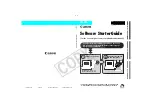
Introduction to the Guide
iii
The output returned in response to the command (in this case, the contents of the directory) is
shown in this style.
prompt
A prompt, which is a computer’s way of signifying that it is ready for you to input something, is
shown in this style. Examples:
$
#
[stephen@maturin stephen]$
leopard login:
user input
Text that the user has to type, either on the command line, or into a text box on a GUI screen, is
displayed in this style. In the following example,
text
is displayed in this style:
To boot your system into the text based installation program, you must type in the
text
com-
mand at the
boot:
prompt.
replaceable
Text used for examples, which is meant to be replaced with data provided by the user, is displayed
in this style. In the following example,
version-number
is displayed in this style:
The directory for the kernel source is
/usr/src/kernels/
version-number
/
, where
version-number
is the version and type of kernel installed on this system.
Additionally, we use several different strategies to draw your attention to certain pieces of information.
In order of how critical the information is to your system, these items are marked as a note, tip,
important, caution, or warning. For example:
Note
Remember that Linux is case sensitive. In other words, a rose is not a ROSE is not a rOsE.
Tip
The directory
/usr/share/doc/
contains additional documentation for packages installed on your
system.
Important
If you modify the DHCP configuration file, the changes do not take effect until you restart the DHCP
daemon.
Содержание NETWORK 3.7 -
Страница 1: ...Red Hat Network 3 7 Reference Guide...
Страница 8: ......
Страница 54: ...42 Chapter 4 Red Hat Network Alert Notification Tool...
Страница 68: ...56 Chapter 5 Red Hat Network Registration Client...
Страница 140: ...128 Chapter 7 Monitoring...
Страница 148: ...136 Appendix A Command Line Config Management Tools...
Страница 152: ...140 Appendix B RHN API Access...
Страница 200: ...188 Glossary...
Страница 208: ......












































